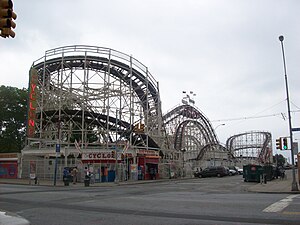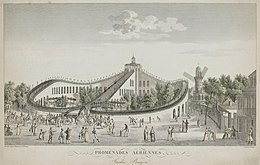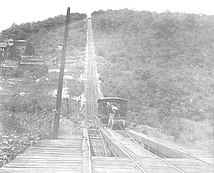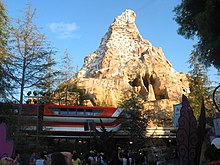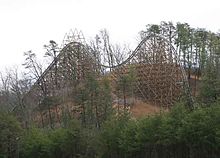
A roller coaster is a type of amusement ride employing a form of elevated railroad track that carries passengers on a train through tight turns, steep slopes, and other elements designed to produce a thrilling experience. Trains consist of open cars connected in a single line, and the rides are often found in theme parks around the world. Roller coasters first appeared in the 17th century, and LaMarcus Adna Thompson obtained one of the first known patents for a roller coaster design in 1885, based on the Switchback Railway which opened a year earlier at Coney Island.

A wooden roller coaster is a type of roller coaster classified by its wooden track, which consists of running rails made of flat steel strips mounted on laminated wood. The support structure is also typically made of wood, but may also be made of steel lattice or truss, which has no bearing on a wooden coaster's classification. The type of wood often selected in the construction of wooden coasters worldwide is southern yellow pine, which grows abundantly in the southern United States, due to its density and adherence to different forms of pressure treatment.

A steel roller coaster is a roller coaster that is defined by having a track made of steel. Steel coasters have earned immense popularity in the past 50 years throughout the world. Incorporating tubular steel track and polyurethane-coated wheels, the steel roller coasters can provide a taller, smoother, and faster ride with more inversions than a traditional wooden roller coaster.

The generic roller coaster vertical loop, also known as a Loop-the-loop, or a Loop-de-loop, where a section of track causes the riders to complete a 360 degree turn, is the most basic of roller coaster inversions. At the top of the loop, riders are completely inverted.

A roller coaster inversion is a roller coaster element in which the track turns riders upside-down and then returns them to an upright position. Early forms of inversions were circular in nature and date back to 1848 on the Centrifugal railway in Paris. These vertical loops produced massive g-force that was often dangerous to riders. As a result, the element eventually became non-existent with the last rides to feature the looping inversions being dismantled during the Great Depression. In 1975, designers from Arrow Development created the corkscrew, reviving interest in the inversion during the modern age of steel roller coasters. Elements have since evolved from simple corkscrews and vertical loops to more complex inversions such as Immelmann loops and cobra rolls. The Smiler at Alton Towers holds the world record for the number of inversions on a roller coaster with 14.

An inverted roller coaster is a type of steel roller coaster in which the train runs under the track with the seats directly attached to the wheel carriage. Riders are seated in open cars, letting their feet swing freely. The inverted coaster was pioneered by Swiss roller coaster manufacturer Bolliger & Mabillard in the early 1990s with the development of Batman: The Ride, which opened at Six Flags Great America on May 9, 1992.

Six Flags Magic Mountain, formerly known and colloquially referred to as simply Magic Mountain, is a 209-acre (85 ha) amusement park located in Valencia, California, 35 miles (56 km) northwest of downtown Los Angeles. It opened on May 29, 1971, as a development of the Newhall Land and Farming Company and Sea World Inc. In 1979, Six Flags purchased the park and added "Six Flags" to the park's name.

Arrow Dynamics was an American manufacturing and engineering company that specialized in designing and building amusement park rides, especially roller coasters. Based in Clearfield, Utah, the company was the successor to Arrow Development (1946–1981) and Arrow Huss (1981–1986), which were responsible for several influential advancements in the amusement and theme park industries. Among the most significant was tubular steel track, which provided a smoother ride than the railroad style rails commonly used prior to the 1960s on wooden roller coasters. The Matterhorn Bobsleds at Disneyland, built in 1959, was Arrow's first roller coaster project.

A shuttle roller coaster is any roller coaster that ultimately does not make a complete circuit, but rather reverses at some point throughout its course and traverses the same track backwards. These are sometimes referred to as boomerang roller coasters, due to the ubiquity of Vekoma's Boomerang coaster model.
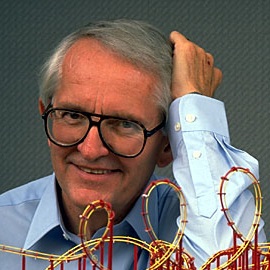
Ronald Valentine Toomer was an American roller coaster designer credited for designing 93 roller coasters around the world. He graduated from the University of Nevada, Reno in 1961 with a degree in mechanical engineering and was a part of the design team responsible for the Apollo spacecraft heat shield.

Viper is a steel roller coaster located at Six Flags Darien Lake amusement park in Darien, New York, United States. Built by the newly-formed Arrow Huss, the ride opened in 1982 as the first roller coaster in the world to feature five inversions, surpassing Carolina Cyclone at Carowinds which featured four. Viper retained the inversions record until Vortex opened at Kings Island in 1987.

The Nighthawk is a steel flying roller coaster from Vekoma located at Carowinds amusement park. The roller coaster is located in the Thunder Road section of the park. The roller coaster originally opened as Stealth at California's Great America on April 1, 2000. In 2003, Paramount Parks decided to relocate the roller coaster to Carowinds. It reopened as Borg Assimilator – the first coaster in the world to be themed to Star Trek – on March 20, 2004. After Cedar Fair purchased Carowinds in 2006, Paramount themes were soon removed from the park, and the ride was renamed Nighthawk. It is one of only two Flying Dutchman models still in existence from Vekoma.

Vortex was a steel roller coaster located at Kings Island amusement park in Mason, Ohio, United States. Designed and manufactured by Arrow Dynamics at a cost of $4 million, the ride officially opened to the public on April 11, 1987. Vortex debuted as the tallest, full-circuit roller coaster in the world with a height of 148 feet (45 m). It was also the first coaster to feature six inversions.

The Tennessee Tornado is a roller coaster at Dollywood amusement park in Pigeon Forge, Tennessee, United States. It debuted April 17, 1999, and was Dollywood's first major coaster expansion as well as one of Arrow Dynamics' last major coasters. The ride opened in a valley location previously occupied by Thunder Express, an Arrow Dynamics Mine Train roller coaster relocated from Six Flags St. Louis in 1989 and opened in 2002 at Magic Springs and Crystal Falls.

Firehawk was a flying roller coaster located at Kings Island in Mason, Ohio. Manufactured by Vekoma, it originally opened as X-Flight at Six Flags Worlds of Adventure on May 26, 2001, billed as the Midwest's first and only flying roller coaster. Cedar Fair purchased Worlds of Adventure in 2004 and began efforts to downsize the park. X-Flight was relocated to Kings Island following the 2006 season, where it reopened as Firehawk on May 26, 2007.
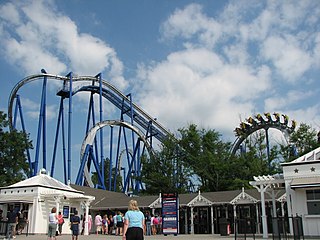
Afterburn is an inverted roller coaster located at Carowinds amusement park in Charlotte, North Carolina. After more than two years of planning and construction, the roller coaster opened on March 20, 1999. The ride previously operated as Top Gun: The Jet Coaster, before it was renamed following Cedar Fair's purchase of Paramount Parks in 2006.
Curtis D. Summers was an American engineer and roller coaster designer credited for designing or providing structural engineering on 25 wooden roller coasters around the world. He earned a degree in Architectural Engineering from Kansas State University and was a registered engineer in 40 states.
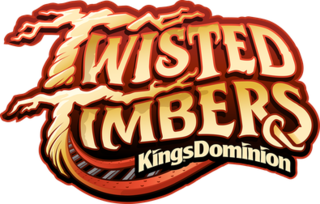
Twisted Timbers is a hybrid roller coaster located at Kings Dominion in Doswell, Virginia. It originally opened as a wooden coaster named Hurler in 1994, designed and manufactured by International Coasters, Inc. It is an exact clone of Hurler at Carowinds. The ride closed for "extensive maintenance" in 2015 according to the park, which later teased in 2016 that Hurler was being replaced.
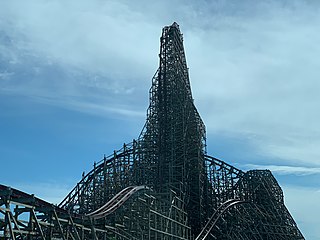
A hybrid roller coaster is a category of roller coasters where the track is made out of one material, either steel or wood, and the support structure is made from another. Early hybrid coasters include mine train roller coasters from Arrow Development, which feature a steel track with a wooden support structure. Becoming increasingly more common are hybrids with wooden tracks and steel supports, such as The Voyage at Holiday World.
